 CHRISTIAN SYMBOLOGY
CHRISTIAN SYMBOLOGY
Enjoy the site? Click here to buy the paperback book ($24.99) or PDF book ($9.99)!
© 2001-2025 by Doug Gray. All Rights Reserved.
 CHRISTIAN SYMBOLOGY
CHRISTIAN SYMBOLOGY
Enjoy the site? Click here to buy the paperback book ($24.99) or PDF book ($9.99)!
© 2001-2025 by Doug Gray. All Rights Reserved.
A monogram is one or more letters put together to form a symbol. Monograms date back to the first century and are among Christianity’s oldest symbols. Today, monograms are frequently used to decorate churches, liturgical clothing and tombstones.
Monograms connected to Jesus Christ (Chi Rho, etc.) are called chrismons. The term chrismon comes from two Latin words Christi Monogramma which mean “monogram of Christ.” Chrismon trees, a tradition started in American churches in the mid-1900’s, display various chrismons. SEE ALSO:Holidays: Christmas Trees.
In this chapter you will find various monograms, letters and even entire Latin phrases you might encounter in your church.
AD MAJOREM DEI GLORIAM – A Latin phrase meaning “to the greater glory of God.”
ADONAI – The Hebrew word for “Lord.” Whenever a Rabbi is reading Scripture aloud and comes to the sacred name of God, YHWH, he will substitute the word Adonai in it’s place.
AGNUS DEI – Latin for “Lamb of God.”
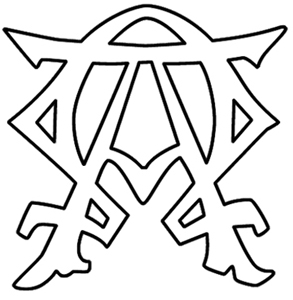
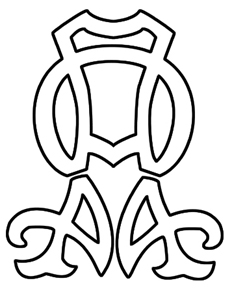

ALPHA & OMEGA – 1. This monogram is based on Revelation 1:8 where Jesus declares that He is the “first and the last, the beginning and the end.” Jesus was making the claim that He existed before anything was created, and thus took part in its creation. His statement also means He will continue to exist after this world comes to an end. This symbol was very important in the early church as it was used to make a statement against the heresy called Arianism. Arianism was a cult that sprang from Christianity in the early days of the church. Arianism taught that Jesus sprang from God the Father, suggesting that Jesus was not present in the beginning with the Father; this implied that Jesus was not equal with the Father.
The symbol is formed by combining the first letter of the Greek alphabet (Alpha) and the last letter (Omega). When displayed, the Alpha & Omega are usually paired together, although on rare occasions they are shown individually. It is not uncommon to show them together with an image of Jesus.
2. A variation of the Alpha & Omega has been found that contains the Greek letter “Mu” which is found in the middle of the Greek alphabet. When included in the symbol, it is located between the Alpha and Omega. This symbolizes that Jesus was and will be involved with the beginning, continuation and the end of all things.
AMEN – A Hebrew word meaning “true,” “certain” and “may it be so.”
AVE MARIA - Latin for “Hail Mary”. It is sometimes called the “Angelical salutation”. It is the most common prayer used by the Catholic church to honor Mary.




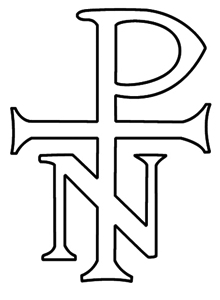
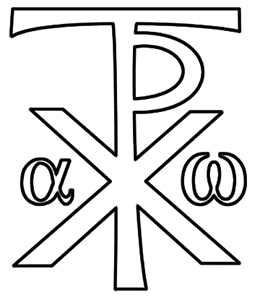
CHI RHO – 1. This monogram is the oldest known monogram of Jesus Christ dating back to the second century. It is sometimes referred to as a Christogram. The Chi (χ = ch) and the Rho (ρ = r) are the first three letters of Christ (Christos) in the Greek language. When displayed a line above the letters shows it is an abbreviation. In the example above, the next letter “I” is shown. The symbol can be frequently found carved in the catacombs, on tombs and wall paintings.
There are many artistic variations of the Chi Rho. 2. The Chi Rho is sometimes shown with the letter “N”. What word the “N” represents is up for debate. It could be the word "nika" meaning “to conquer.” The meaning of this symbol would be “Christ conquers.” It could also be the word Noster meaning “our Lord.” In this case, the symbol would read “Christ our Lord.” 3. The Chi Rho design can be combined with doves or doves wings. This symbolizes peace in Christ and was very popular at burial sites. 4. The Chi Rho is often combined with other monograms such as the alpha and omega and Ihs to form some interesting and beautiful combinations. One example above is combined with the Tau cross.
The Chi Rho’s popularity got a strong boost after Constantine, a great military commander and disputed Roman Emperor, was on his way to a difficult battle at the Milvian Bridge. At the bridge a larger and stronger army under the leadership of Maxentius awaited him. There are two different takes on what happened next. Some historians say that as Constantine prepared for battle, he saw a vision in the sky of the Chi Rho and heard a voice proclaim, “In this sign you shall conquer.” Others say that he had a dream that evening, and that someone in the dream told him to affix the symbol to his shields and to then go and face the enemy.1 The later account is most likely true; but, in either case, Constantine quickly ordered the Chi Rho painted on all of his soldiers’ shields and standards. That day his army won a decisive, upset victory at the Milvian Bridge, allowing him to march on Rome and conquer it. The experience would deeply impact Constantine and would solidify his positive attitude towards both Christ and Christianity. It would be under Constantine the Great that Christianity would become a legal religion throughout the Roman Empire, causing the church to explode in both size and popularity.
DEXTRA DOMINI – Latin for “the right hand of the Lord.” It always accompanies an image of a hand.
DOMINUS NOSTER JESUS CHRISTUS – Latin for “Our Lord Jesus Christ”.
ECCE AGNUS DEI – Latin for “behold the Lamb of God.” John the Baptist said this when he saw Jesus approaching him (John 1:29).
ECCE HOMO – Latin for “behold the man.” This exclamation was made by Pontius Pilate as he presented Jesus to the Jews (John 19:5).
EMMANUEL (IMMANUEL) – A greek word (second spelling is the Hebrew word) for “God with us.” The word is found in Isaiah 7:14, “Therefore the Lord himself will give you a sign. Behold, the virgin shall conceive and bear a son, and shall call his name Immanuel.”
IC XC – An abbreviation of the Greek name Jesus (Iasous) Christ (Christos). The first and last letters of both Jesus (IC) and Christ (XC) are placed together to form this monogram. The “s” and “c” in the Greek language were interchangable, as they made the same sounds. That is why a “c” is used in the symbol in place of the “s.”

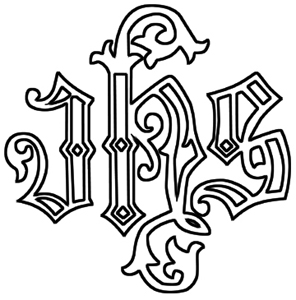

IHS (Ihc) – 1. The Ihs monogram is a very old symbol, dating back to the first century. Ihs is the abbreviation of the Greek name Jesus (Iasous) pronounced ‘hasous. Because Ihs is an abbreviation, there should never be periods after the I, h, and s. When portrayed in art, the artist will include a line above the hs to show it is an abbreviation. Grammatically, the monogram can be written in two forms, as Ihs or as Ihc. The Ihc is grammatically more correct because the letter “s” (sigma) is represented as a “c” when in the middle of a word. However, it is an “s” when at the end of the word. 2. The Latin phrase Iesus Hominum Salvator (Jesus, Savior of Men) can be abbreviated as I.H.S. 3. A German phrase Jesus, Heiland, Seligmacher (Jesus, Lord, Savior) can be abbreviated I.H.S. 4. There is growing popularity in I.H.S. being an abbreviation for the phrase “In His Service.” However, this is a more modern meaning and should never be substituted for the primary meaning, especially in church settings where it is found on various objects such as the cross, Communion instruments, and altars.
INRI – A representation of the words written on the sign above the cross on which Jesus was crucified (John 19:19). The letters stand for the Latin phrase Iesus Nazarenus Rex Iudaeorum meaning “Jesus of Nazareth the King of the Jews” (John 19:19).
KYRIE ELEISON - Greek for "Lord, have mercy."

N – 1. A shortening of the Greek word Nika meaning “to conquer.” 2. A shortening of the Greek word Noster meaning “lord.” 3. A letter tied to an event that happened in 2014 when Islamic radicals (ISIS) attacked Christians in Mosul, Iraq. They spraypainted the Arabic letter Msara (shown here) on their doors, meaning, “Followers of Jesus of Nazareth”. The symbol now stands for the persecuted church.
NOEL – Noel is a French word for Christmas derived from the Latin word natalis, meaning “natal birthday” which refers back to the birth of Jesus.
NOLI ME TANGERE – Latin for “Do not cling to me.” This phrase was said by Jesus to Mary Magdalene in the garden after His death and Resurrection (John 20:17).
PAROUSIA – Greek word for “Advent”. It refers to Jesus’ second coming.
PATER NOSTER – The Latin words for “our father.”
PAX – The Latin word for “peace.”
POST TENEBRAS LUX – Latin for “after darkness, light.” Post tenebras lux was the cry during the Reformation, referring to the recovery of the doctrine of justification. It also refers to broader events, such as the renewing of worship and the growing availability of the Bible for the average person to read.
REGINA COELI - The opening words of the Easter song to the Virgin Mary.
SANCTUS – Latin word for “holy.”
SOLAS - A Latin word meaning “alone”. The Protestant Reformers, in seeking to return the church to it’s Biblical roots, emphasized five key theological points (alones) to guide the church and the saints.
1. Sola Scriptura: “Scripture alone”. The Bible alone is the source of authority to guide faith and practice. The Reformers altogether rejected the divine authority of the Roman Catholic pope and any doctrine based solely on church tradition.
2. Sola Fide: “faith alone”. Salvation is received by faith only. The Reformers rejected the words added to gain salvation by the Roman Catholic Church as well as actions such as baptism into the Roman church and buying indulgences from the church to buy status with God.
3. Sola Gratia: “grace alone”. A person is saved by grace only and not of works (Eph. 2:8-9). It is what God has done for the sinner, not what the sinner has done for God that saves them.
4. Solo Christo: meaning “Christ alone”. The Reformers rejected the idea of Roman Catholic priests as mediators between God and sinners. Christ alone is the sinner’s great High Priest, intercessor, and Savior.
5. Soli Deo Gloria: meaning “to the glory of God alone”. May all that is said and done be for God’s glory alone.
SPES PUBLICA – Latin for “hope of mankind.”
SPIRITUS GLADIUS – Latin for “sword of the Spirit.”
SPIRITUS SANCTUS (Abbr. Spus Scus) - Latin for “Holy Spirit.”
T – The first letter in the Greek word Theos meaning “God.”
V.D.M. – Latin for Verbi Divini Minister which means “Minister (servant) of the Word of God”.
V.D.M.A. – Latin for Verbum Dei Manet Aeternum which means “The Word of God endures forever.”
VITA – The Latin word for “life.” It is often combined with MORS which is Latin for “death.” The two were often displayed together, sometimes on the opposing arms of a cross.
X – A letter used to abbreviate the word Christ in a word (i.e. Xmas). The X is used because it stands for the Greek letter “Chi” (χ = ch) which is the first letter in “Christos” meaning Christ.
YHWH – The sacred name of God known as the Tetragrammaton. When a Jew comes to this word while reading Scripture out loud, he will use the substitute word Adonai, meaning “Lord,” instead. While we are unsure how the word is pronounced, it is thought to be spelled “Yahweh”. Later through translation, the “Y” became a “J” and the “W” a “V”. Since Adonai is said instead of JHVH, the vowels from Adonai were added to the consonants and the name “Jehovah” resulted.